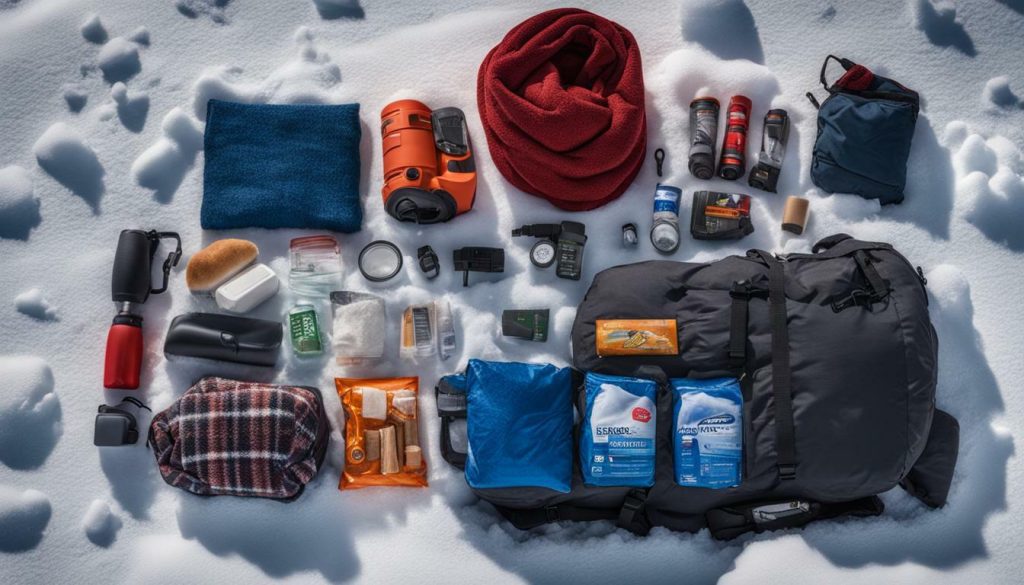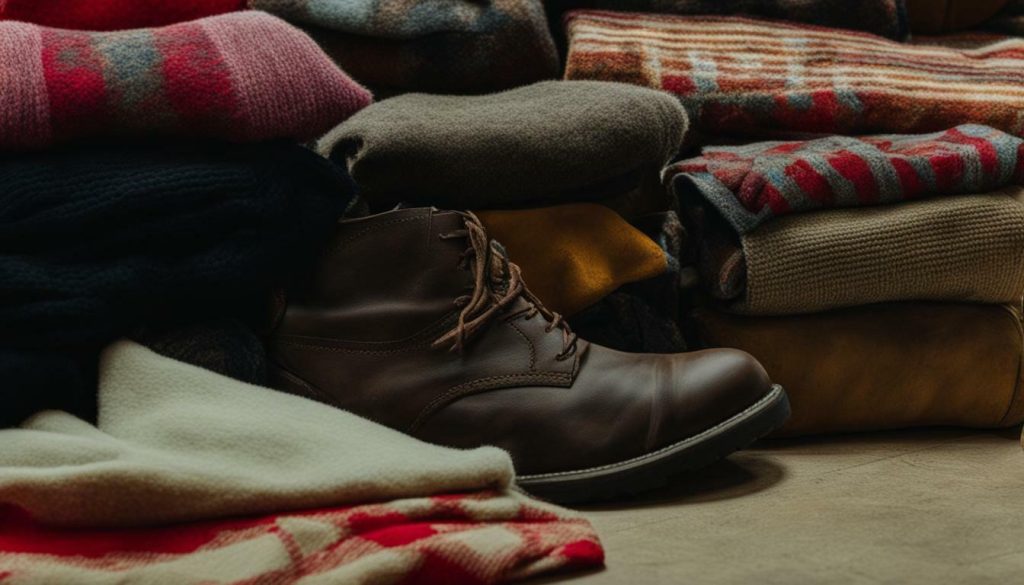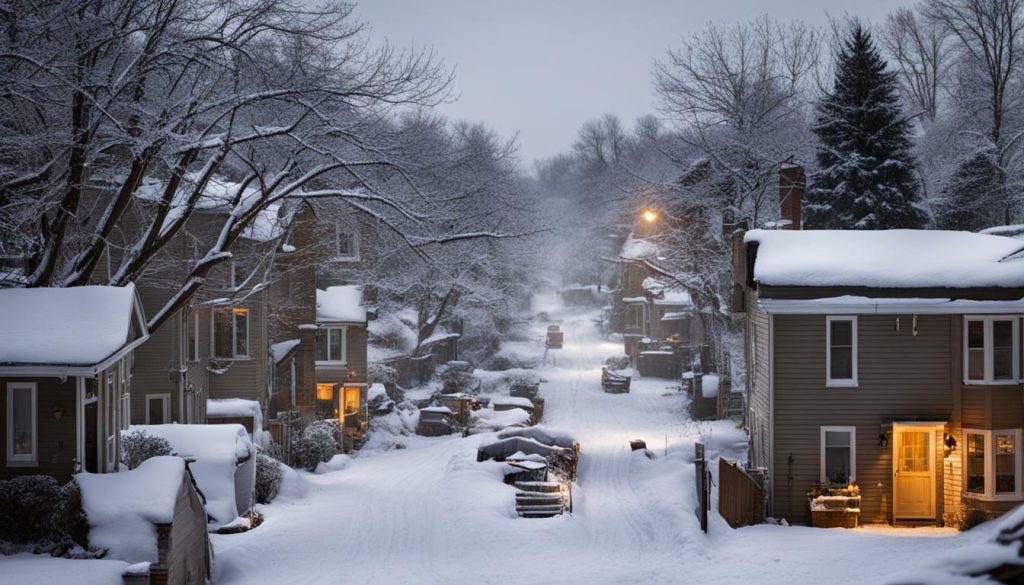

When a winter storm hits, it’s crucial to have a comprehensive checklist to ensure your safety and well-being. Whether you’re at home or on the road, being prepared with the right supplies and knowledge can make all the difference. Let’s dive into the essential steps you need to take for winter storm preparedness.
Key Takeaways:
- Stock up on necessary supplies for your home, office, and vehicles.
- Stay informed about weather conditions and warnings.
- Dress warmly and have warm fluids to drink.
- Gather emergency supplies and important documents.
- Take precautions to prevent fires, frostbite, and hypothermia.
Essential Supplies for Winter Storm Preparedness
To be fully prepared for a winter storm, it’s essential to have the right supplies readily available in case of an emergency. Whether you’re hunkering down at home or traveling, having the necessary items can make all the difference in your safety and comfort. Here’s a comprehensive list of winter storm supplies to keep on hand:
Emergency Kit
- Flashlight and extra batteries
- Battery-powered NOAA Weather Radio and a portable radio
- Mobile phone and charger
- Blankets and warm clothing
- First-aid kit and necessary medications
- Non-perishable food and water
Winter Driving Essentials
If you’re venturing out on the roads during a winter storm, it’s crucial to have the following items in your vehicle:
- Ice scraper and snow brush
- Tire chains or traction mats
- Jumper cables
- Shovel
- Sand or cat litter for traction
Home Preparation
When preparing your home for a winter storm, consider these precautions:
- Heating fuel and emergency heat source
- Fire extinguisher, smoke alarm, and carbon monoxide detector
- Extra fuel for generators or backup power sources
- Insulation for pipes and water supply
| Recommended Supplies | Quantity |
|---|---|
| Non-perishable food | 3-day supply per person |
| Water | 1 gallon per person per day |
| Warm clothing and blankets | One set per person |
| Medications | At least a week’s supply |
Remember, being prepared is the key to staying safe and comfortable during a winter storm. Take the time now to gather the necessary supplies and create an emergency plan for your household. It’s always better to be over-prepared than to find yourself without the essentials when you need them the most.
With these winter storm supplies and precautions in place, you can face the icy weather conditions with confidence. Stay safe and warm!


Staying Safe and Warm During a Winter Storm
Knowing how to stay safe and warm during a winter storm is vital for your well-being and that of your family. Winter weather can bring frigid temperatures, icy conditions, and power outages, so it’s important to be prepared. Here are some essential winter storm safety tips to help you navigate through the cold:
- Dress appropriately: Layering your clothing is key to staying warm. Start with a moisture-wicking base layer, add insulating layers, and top it off with a waterproof outer layer. Don’t forget to wear a hat, scarf, and gloves to protect your extremities.
- Keep your home warm: Maintain a comfortable temperature indoors by using safe heating sources. Make sure your fireplace and space heaters are properly ventilated, and never leave them unattended. Keep blankets and extra clothing handy in case the power goes out.
- Prevent frostbite and hypothermia: Be mindful of the early signs of frostbite, such as numbness or white or grayish-yellow skin. If you suspect frostbite, seek medical attention immediately. To prevent hypothermia, stay dry and change out of wet clothing promptly.
- Stay informed: Stay updated on the latest weather conditions and forecasts. Have a battery-powered NOAA Weather Radio and a portable radio to receive emergency information. Follow local authorities’ advice and instructions to ensure your safety.
- Prepare an emergency kit: Create a winter storm survival kit that includes essential items such as a flashlight, extra batteries, non-perishable food, water, a first-aid kit, and a battery-powered or hand-crank radio. Also, have extra prescription medications, baby supplies, and pet food on hand.
- Take precautions when traveling: If you must travel during a winter storm, make sure your vehicle is equipped with a Winter Storm Survival Kit. This kit should include items such as a mobile phone, charger, blankets, flashlight, first-aid kit, warm clothing, water, and non-perishable snacks.
- Protect your pets: Move animals to sheltered areas or bring them indoors during a winter storm. Ensure they have access to fresh water and don’t expose them to prolonged cold temperatures.
Remember, being prepared and taking necessary precautions can help you stay safe and warm during a winter storm. Stay vigilant, stay informed, and prioritize your well-being and that of your loved ones.


| Signs of Frostbite | Treatment for Frostbite |
|---|---|
| Numbness | Seek immediate medical attention |
| Unusual skin color (white or grayish-yellow) | Move to a warm area and avoid rubbing or massaging the affected area |
| Hard or waxy skin | Avoid using direct heat (such as a heating pad) to rewarm the area |
| Blisters or swelling | Elevate the affected area and protect it from further injury |
Remember, prevention is the best defense against winter storm hazards. Take the necessary steps to prepare yourself and your home for extreme winter weather to ensure a safe and warm experience.
Conclusion
In conclusion, staying safe and warm during a winter storm requires preparation, vigilance, and knowledge of winter storm safety tips. Dressing appropriately, keeping your home warm, preventing frostbite and hypothermia, staying informed, and preparing an emergency kit are crucial steps to protect yourself and your loved ones. Whether you’re staying indoors or traveling, following these guidelines will help you navigate through the challenges posed by winter weather. Stay safe, stay warm, and take care of yourself and those around you.
What to Do in Case of Emergency or Stranded During a Winter Storm
In the event of an emergency or being stranded during a winter storm, it’s crucial to know the necessary steps to ensure your safety and survival. Here are some important precautions to take:
1. Stay inside the vehicle: If you find yourself stranded in your vehicle, it is generally safer to stay inside until help arrives. This will provide you with shelter from the elements and help conserve body heat.
2. Display a trouble sign: Use hazard lights or tie a brightly colored cloth to your antenna or door handle to alert rescuers that you need assistance.
3. Stay warm: Take measures to keep warm by using blankets, extra clothing, and turning on the vehicle’s engine for short intervals to conserve fuel and heat the interior. However, ensure that the exhaust pipe is clear of snow to prevent carbon monoxide buildup.
4. Be prepared: Always keep a Winter Storm Survival Kit in your vehicle, which should include essentials such as a mobile phone, charger, blankets, flashlight, first-aid kit, warm clothing, water, and non-perishable food items.
5. Follow safety guidelines: Avoid using generators or grills inside the vehicle, as this can lead to carbon monoxide poisoning. Keep ventilation clear and open a window slightly for fresh air if needed.
Remember, being prepared and staying calm are key during a winter storm emergency. By following these guidelines and having the necessary supplies, you can ensure your safety and increase your chances of survival.
FAQ
What should I stock up on for winter storm preparedness?
It is important to have essential supplies such as food, water, batteries, flashlights, a portable radio, extra medication, and warm clothing.
How can I stay warm and safe during a winter storm?
To stay warm, dress in layers and have blankets, a heating source, and warm fluids available. It is also important to stay informed about weather conditions and warnings.
What should I do if I find myself stranded during a winter storm?
If stranded, stay inside the vehicle, display a trouble sign for help, and take measures to stay warm. It is also important to have emergency supplies in your vehicle.
How can I prevent carbon monoxide poisoning during a winter storm?
To prevent carbon monoxide poisoning, avoid using generators and grills indoors or near windows. Follow generator safety guidelines and ensure proper ventilation.
What are the signs and treatments for frostbite and hypothermia?
Signs of frostbite include numbness, pale or waxy skin, and blistering. Hypothermia symptoms include shivering, confusion, and loss of coordination. Seek medical attention immediately.






